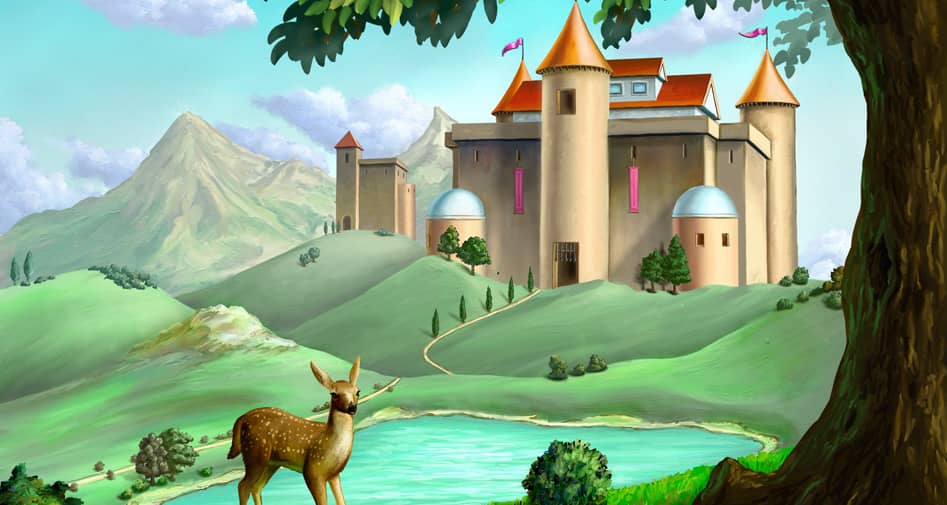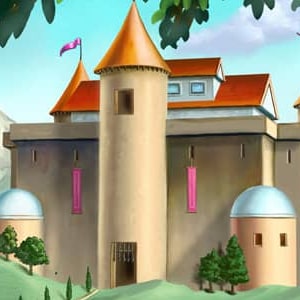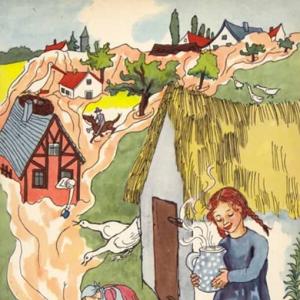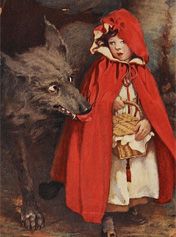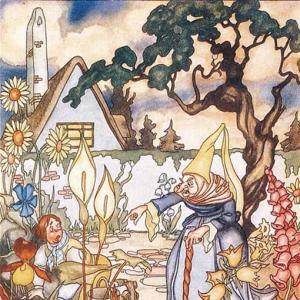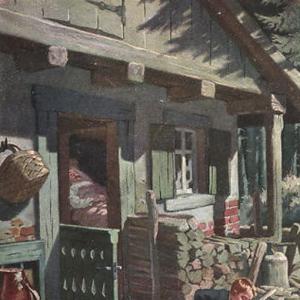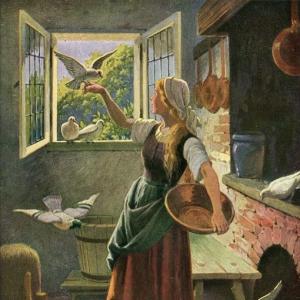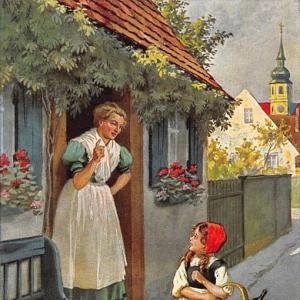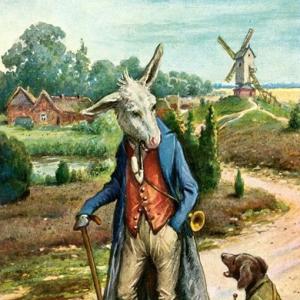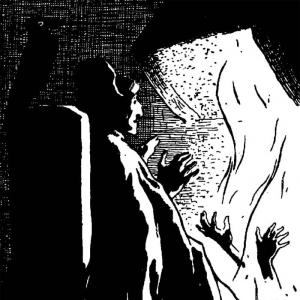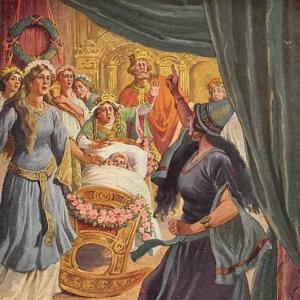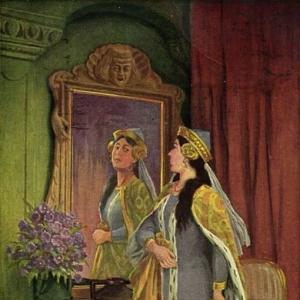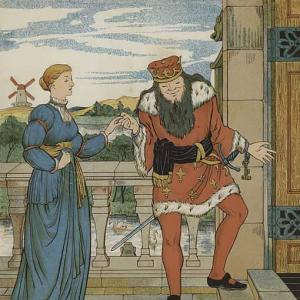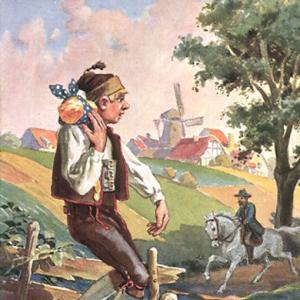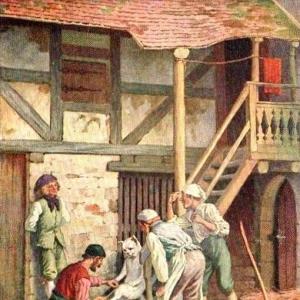Reading time for children: 15 min
There was once a countryman who had money and land in plenty, but how rich soever he was, one thing was still wanting in his happiness he had no children. Often when he went into the town with the other peasants they mocked him and asked why he had no children. At last he became angry, and when he got home he said, „I will have a child, even if it be a hedgehog.“ Then his wife had a child, that was a hedgehog in the upper part of his body, and a boy in the lower, and when she saw the child, she was terrified, and said, „See, there thou hast brought ill-luck on us.“ Then said the man, „What can be done now? The boy must be christened, but we shall not be able to get a godfather for him.“ The woman said, „And we cannot call him anything else but Hans-my-Hedgehog.“ When he was christened, the parson said, „He cannot go into any ordinary bed because of his spikes.“ So a little straw was put behind the stove, and Hans-my-Hedgehog was laid on it. His mother could not suckle him, for he would have pricked her with his quills. So he lay there behind the stove for eight years, and his father was tired of him and thought, „If he would but die!“ He did not die, however, but remained lying there. Now it happened that there was a fair in the town, and the peasant was about to go to it, and asked his wife what he should bring back with him for her. „A little meat and a couple of white rolls which are wanted for the house,“ said she. Then he asked the servant, and she wanted a pair of slippers and some stockings with clocks. At last he said also, „And what wilt thou have, Hans my Hedgehog?“ – „Dear father,“ he said, „do bring me bagpipes.“ When, therefore, the father came home again, he gave his wife what he had bought for her; meat and white rolls, and then he gave the maid the slippers, and the stockings with clocks; and, lastly, he went behind the stove, and gave Hans-my-Hedgehog the bagpipes. And when Hans-my-Hedgehog had the bagpipes, he said, „Dear father, do go to the forge and get the cock shod, and then I will ride away, and never come back again.“ On this, the father was delighted to think that he was going to get rid of him, and had the cock shod for him, and when it was done, Hans-my-Hedgehog got on it, and rode away, but took swine and asses with him which he intended to keep in the forest. When they got there he made the cock fly on to a high tree with him, and there he sat for many a long year, and watched his asses and swine until the herd was quite large, and his father knew nothing about him. While he was sitting in the tree, however, he played his bagpipes, and made music which was very beautiful. Once a King came travelling by who had lost his way and heard the music. He was astonished at it, and sent his servant forth to look all round and see from whence this music came. He spied about, but saw nothing but a little animal sitting up aloft on the tree, which looked like a cock with a hedgehog on it which made this music. Then the King told the servant he was to ask why he sat there, and if he knew the road which led to his kingdom. So Hans-my-Hedgehog descended from the tree, and said he would show the way if the King would write a bond and promise him whatever he first met in the royal courtyard as soon as he arrived at home. Then the King thought, „I can easily do that, Hans-my-Hedgehog understands nothing, and I can write what I like.“ So the King took pen and ink and wrote something, and when he had done it, Hans-my-Hedgehog showed him the way, and he got safely home. But his daughter, when she saw him from afar, was so overjoyed that she ran to meet him, and kissed him. Then he remembered Hans-my-Hedgehog, and told her what had happened, and that he had been forced to promise whatsoever first met him when he got home, to a very strange animal which sat on a cock as if it were a horse, and made beautiful music, but that instead of writing that he should have what he wanted, he had written that he should not have it. Thereupon the princess was glad, and said he had done well, for she never would have gone away with the Hedgehog.
Hans-my-Hedgehog, however, looked after his asses and pigs, and was always merry and sat on the tree and played his bagpipes. Now it came to pass that another King came journeying by with his attendants and runners, and he also had lost his way, and did not know how to get home again because the forest was so large. He likewise heard the beautiful music from a distance, and asked his runner what that could be, and told him to go and see. Then the runner went under the tree, and saw the cock sitting at the top of it, and Hans-my-Hedgehog on the cock. The runner asked him what he was about up there? „I am keeping my asses and my pigs; but what is your desire?“ The messenger said that they had lost their way, and could not get back into their own kingdom, and asked if he would not show them the way. Then Hans-my-Hedgehog got down the tree with the cock, and told the aged King that he would show him the way, if he would give him for his own whatsoever first met him in front of his royal palace. The King said, „Yes,“ and wrote a promise to Hans-my-Hedgehog that he should have this. That done, Hans rode on before him on the cock, and pointed out the way, and the King reached his kingdom again in safety. When he got to the courtyard, there were great rejoicings. Now he had an only daughter who was very beautiful. She ran to meet him, threw her arms round his neck, and was delighted to have her old father back again. She asked him where in the world he had been so long. So he told her how he had lost his way, and had very nearly not come back at all, but that as he was travelling through a great forest, a creature, half hedgehog, half man, who was sitting astride a cock in a high tree, and making music, had shown him the way and helped him to get out, but that in return he had promised him whatsoever first met him in the royal court-yard, and how that was she herself, which made him unhappy now. But on this she promised that, for love of her father, she would willingly go with this Hans if he came.
Hans-my-Hedgehog, however, took care of his pigs, and the pigs multiplied until they became so many in number that the whole forest was filled with them. Then Hans-my-Hedgehog resolved not to live in the forest any longer, and sent word to his father to have every stye in the village emptied, for he was coming with such a great herd that all might kill who wished to do so. When his father heard that, he was troubled, for he thought Hans-my-Hedgehog had died long ago. Hans-my-Hedgehog, however, seated himself on the cock, and drove the pigs before him into the village, and ordered the slaughter to begin. Ha! but there was a killing and a chopping that might have been heard two miles off! After this Hans-my-Hedgehog said, „Father, let me have the cock shod once more at the forge, and then I will ride away and never come back as long as I live.“ Then the father had the cock shod once more, and was pleased that Hans-my-Hedgehog would never return again.
Hans-my-Hedgehog rode away to the first kingdom. There the King had commanded that whosoever came mounted on a cock and had bagpipes with him should be shot at, cut down, or stabbed by everyone, so that he might not enter the palace. When, therefore, Hans-my-Hedgehog came riding thither, they all pressed forward against him with their pikes, but he spurred the cock and it flew up over the gate in front of the King’s window and lighted there, and Hans cried that the King must give him what he had promised, or he would take both his life and his daughter’s. Then the King began to speak his daughter fair, and to beg her to go away with Hans in order to save her own life and her father’s. So she dressed herself in white, and her father gave her a carriage with six horses and magnificent attendants together with gold and possessions. She seated herself in the carriage, and placed Hans-my-Hedgehog beside her with the cock and the bagpipes, and then they took leave and drove away, and the King thought he should never see her again. He was however, deceived in his expectation, for when they were at a short distance from the town, Hans-my-Hedgehog took her pretty clothes off, and pierced her with his hedgehog’s skin until she bled all over. „That is the reward of your falseness,“ said he. „go your way, I will not have you!“ and on that he chased her home again, and she was disgraced for the rest of her life.
Hans-my-Hedgehog, however, rode on further on the cock, with his bagpipes, to the dominions of the second King to whom he had shown the way. This one, however, had arranged that if any one resembling Hans-my-Hedgehog should come, they were to present arms, give him safe conduct, cry long life to him, and lead him to the royal palace. But when the King’s daughter saw him she was terrified, for he looked quite too strange. She remembered however, that she could not change her mind, for she had given her promise to her father. So Hans-my-Hedgehog was welcomed by her, and married to her, and had to go with her to the royal table, and she seated herself by his side, and they ate and drank. When the evening came and they wanted to go to sleep, she was afraid of his quills, but he told her she was not to fear, for no harm would befall her, and he told the old King that he was to appoint four men to watch by the door of the chamber, and light a great fire, and when he entered the room and was about to get into bed, he would creep out of his hedgehog’s skin and leave it lying there by the bedside, and that the men were to run nimbly to it, throw it in the fire, and stay by it until it was consumed. When the clock struck eleven, he went into the chamber, stripped off the hedgehog’s skin, and left it lying by the bed. Then came the men and fetched it swiftly, and threw it in the fire; and when the fire had consumed it, he was delivered, and lay there in bed in human form, but he was coal-black as if he had been burnt. The King sent for his physician who washed him with precious salves, and anointed him, and he became white, and was a handsome young man. When the King’s daughter saw that she was glad, and the next morning they arose joyfully, ate and drank, and then the marriage was properly solemnized, and Hans-my-Hedgehog received the kingdom from the aged King.
When several years had passed he went with his wife to his father, and said that he was his son. The father, however, declared he had no son he had never had but one, and he had been born like a hedgehog with spikes, and had gone forth into the world. Then Hans made himself known, and the old father rejoiced and went with him to his kingdom.
 Learn languages. Double-tap on a word.Learn languages in context with Childstories.org and Deepl.com.
Learn languages. Double-tap on a word.Learn languages in context with Childstories.org and Deepl.com.Backgrounds
Interpretations
Adaptions
Summary
Linguistics
„Hans my Hedgehog“ is a German fairy tale collected by the Brothers Grimm, Jacob and Wilhelm, in their anthology „Grimms‘ Fairy Tales“ or „Children’s and Household Tales“ (Kinder- und Hausmärchen), first published in 1812. The Brothers Grimm were scholars, linguists, and cultural researchers who collected and recorded many of the folktales that have become well-known fairy tales today. Their work was part of the Romantic-era movement, which aimed to preserve the German cultural heritage.
The tale of Hans-my-Hedgehog falls under the Aarne-Thompson-Uther (ATU) classification system as Type 441, „Hans My Hedgehog“ or „The Hedgehog as Herdsman.“ The ATU classification system is a widely recognized system that categorizes folktales based on their structure and theme.
„Hans my Hedgehog“ shares similarities with other European tales featuring animal-groom characters, such as the French „Beauty and the Beast“ and the Norwegian „East of the Sun and West of the Moon.“ In these stories, the protagonists often undergo a transformation or reveal their true identity, highlighting themes of inner beauty and personal growth.
„Hans my Hedgehog“ can be interpreted in various ways, offering different messages and themes. Here are three possible interpretations of the fairy tale:
Acceptance and Transformation: The story demonstrates that appearances and circumstances can change over time. Despite being born with a unique appearance and living in isolation, Hans eventually transforms into a handsome young man who inherits a kingdom. This interpretation highlights the importance of accepting people for who they are and the potential for personal growth and transformation.
Deception and Consequences: Both kings encounter Hans-my-Hedgehog and make promises to him, but their actions have different outcomes. The first king, who tries to deceive Hans, ultimately suffers the consequences as his daughter is disgraced for the rest of her life. On the other hand, the second king, who is honest and keeps his word, sees his daughter marry Hans, who then becomes a powerful and kind ruler. This interpretation highlights the importance of honesty and the consequences of deception.
Perseverance and Resilience: Throughout the story, Hans-my-Hedgehog faces numerous challenges, including rejection and isolation from his family and society. Despite these difficulties, he remains resilient and resourceful, eventually finding happiness and success in life. This interpretation emphasizes the importance of perseverance and resilience in overcoming obstacles and achieving one’s goals.
The fairy tale „Hans My Hedgehog“ has been adapted into various forms over the years, including:
Operas: The story has been adapted into several operas, including Engelbert Humperdinck’s „Hansel and Gretel“ (1893), in which Hans My Hedgehog appears as a minor character, and the one-act opera „Hans my Hedgehog“ by Viktor Ullmann (1940).
Children’s books: „Hans My Hedgehog“ has also been adapted into several children’s books, including „Hans My Hedgehog: A Tale from the Brothers Grimm“ by Kate Seredy (1936) and „Hans My Hedgehog: The Fairy Tale“ by the Brothers Grimm and illustrated by Lisbeth Zwerger (1999).
Animated Films: The story has been adapted into several animated films, including a 1950s East German film and a 2002 Spanish film, both titled „Hans My Hedgehog.“
Short Films: There have been several short film adaptations of „Hans My Hedgehog,“ including a 1976 German animated short film and a 2015 Czech Republic stop-motion animated film.
Plays: The story has also been adapted for the stage, including a 2006 play by British playwright Simon Reade called „Hans My Hedgehog: A Grimm Tale.“
Television Shows: „Hans My Hedgehog“ has also been adapted for television, including a 1978 West German television movie and an episode of the animated series „Simsala Grimm“ (1999-2001).
Overall, the story of „Hans My Hedgehog“ has proven to be a popular source for adaptations in various forms of media, continuing to captivate and inspire new generations of audiences.
„Hans my Hedgehog“ is a fairy tale by the Brothers Grimm, which tells the story of a rich countryman who, despite his wealth, is unhappy because he has no children. After expressing his frustration, his wife gives birth to a child that is half-hedgehog, half-boy, named Hans-my-Hedgehog. Due to his unique appearance, Hans spends eight years living behind the stove, unable to be properly cared for by his parents. Eventually, Hans receives a set of bagpipes from his father and decides to leave home. He takes swine and asses to live with him in the forest, and he spends his days playing beautiful music on his bagpipes while sitting on a tree with his pet cock.
Two kings lose their way in the forest and stumble upon Hans-my-Hedgehog’s music. Each king promises Hans whatever he first encounters upon returning to his kingdom in exchange for being guided back home. The first king, however, reneges on his promise and instead writes that Hans-my-Hedgehog should not receive anything. The second king keeps his word, and Hans is promised the king’s beautiful daughter in marriage.
Upon returning to the first kingdom, Hans exposes the king’s deceit and punishes his daughter by piercing her with his quills. She is sent back to her father, disgraced for the rest of her life. In the second kingdom, Hans marries the princess and instructs her father to have his hedgehog skin burned. Once the skin is burned, Hans turns coal-black and must be cleansed by the king’s physician. He is then transformed into a handsome young man.
Hans-my-Hedgehog inherits the kingdom from the old king, and after some time, he returns to his birth father to reveal his true identity. The father rejoices, and they all live happily together in the kingdom.
The fairy tale „Hans my Hedgehog“ by the Brothers Grimm is a rich text for linguistic analysis, offering insights into the narrative structure, character development, and thematic elements typical of fairy tales. Here is a breakdown of some linguistic and thematic features of the story:
Narrative Structure
Opening Formula: The tale begins with the classic „There was once,“ establishing it as a traditional fairy tale. This formulaic opener situates the story in a timeless, unspecified past, characteristic of many folk tales.
Threefold Patterning: Like many fairy tales, „Hans my Hedgehog“ employs a threefold pattern. Hans encounters two kings, each promising him the first thing they see upon returning home. The rule of three is a common motif in folklore, creating rhythm and anticipation.
Character Development
Hans as the Protagonist: Despite his initial appearance, Hans is depicted as a multifaceted character. His physical transformation from a creature half-hedgehog to a handsome man symbolizes personal growth and the overcoming of initial adversity.
Dynamic Traits: Hans shows intelligence and cunning, evident when he outsmarts the first king’s attempt to deceive him and gains a promise from the second king.
Thematic Elements
Transformation and Redemption: Central to the tale is the theme of transformation, both physical and metaphorical. Hans‘ eventual shedding of his hedgehog skin and becoming a handsome man is indicative of personal redemption and societal acceptance.
Promises and Deception: Promises, oaths, and their moral implications play a critical role. The first king’s attempt to deceive Hans contrasts sharply with the second king’s adherence to his promise, offering a moral lesson on integrity.
Language and Style
Simple Syntax: The narrative employs straightforward syntax and repetitive structures typical of oral storytelling, which aids in memorability and audience engagement.
Use of Direct Speech: Dialogue drives much of the story, making it vivid and allowing characters to express emotions and intentions directly. This technique also serves to contrast the sincerity of different characters (e. g. , the honest second king versus the deceitful first king).
Symbolism
The Hedgehog Skin: Hans‘ hedgehog skin is a symbol of his outsider status and the challenges he faces. Its burning represents purification and the shedding of societal prejudice.
The Bagpipes: Gifted to Hans as a child, the bagpipes symbolize his unique identity and perhaps the harmony he brings to his world, despite his unusual appearance.
Moral and Social Commentary: The story offers insights into family dynamics, societal values, and the concept of „the other. “ Hans’ rejection and later acceptance highlight themes of belonging and societal change. Through the character of Hans, the tale explores the notion that true worth lies beyond physical appearance, a common moral in folk narratives.
In summary, „Hans my Hedgehog“ utilizes traditional elements of fairy tales, such as transformation, morality, and the triumph of an underdog, while employing language and structure to reinforce its themes. It reflects the societal values of its time while delivering timeless lessons on acceptance and integrity.
Information for scientific analysis
Fairy tale statistics | Value |
|---|---|
| Number | KHM 108 |
| Aarne-Thompson-Uther-Index | ATU Typ 441 |
| Translations | DE, EN, ES, FR, PT, IT, JA, NL, PL, RU, TR, VI, ZH |
| Readability Index by Björnsson | 38 |
| Flesch-Reading-Ease Index | 74.2 |
| Flesch–Kincaid Grade-Level | 9.5 |
| Gunning Fog Index | 12.4 |
| Coleman–Liau Index | 7.5 |
| SMOG Index | 10.3 |
| Automated Readability Index | 10.5 |
| Character Count | 10.776 |
| Letter Count | 8.326 |
| Sentence Count | 79 |
| Word Count | 2.108 |
| Average Words per Sentence | 26,68 |
| Words with more than 6 letters | 238 |
| Percentage of long words | 11.3% |
| Number of Syllables | 2.631 |
| Average Syllables per Word | 1,25 |
| Words with three Syllables | 119 |
| Percentage Words with three Syllables | 5.6% |
